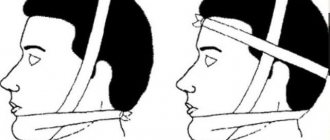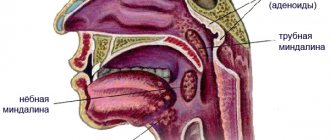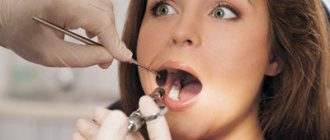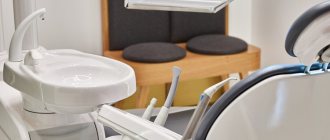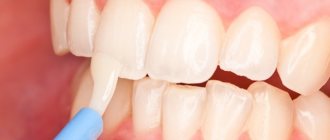The lower jaw of a person is mobile, which allows him to talk, chew food and more. Together with the temporal bones, it forms the mandibular joint. If everything is fine with him, the person does not experience difficulties with chewing, speaking, or eating. Problems begin when the jaw becomes jammed. Thus, a dislocated jaw not only leads to a person’s inability to speak and chew food, but also causes severe pain around the affected joint. The answer to the question “what to do in such a situation” is that it will have to be adjusted, and only by a specialized specialist.
Description and symptoms of jaw joint dislocation
Discomfort in the jaw area most often occurs due to problems with the temporomandibular joint. It is formed by the head of the lower part of the jaw and the tubercle of the temporal bone, which, together with the articular disc, are part of the capsule. The work of this joint is very complex and is associated with a whole set of muscles. If something goes wrong, not only the joint itself suffers, but also the muscles of the neck, head, and cranial nerves, resulting in chronic pain, most often from one – the problematic – part of the head.
Symptoms of TMJ dysfunction are varied - pain in the ears, head, and neck.
Why is it impossible to open your mouth wide or completely?
There are no nerve endings in the joint, so it does not hurt, but discomfort may occur. Toothache also often develops, and there is a feeling of squeezing of the eyes. Another key indicator of TMJ problems is jaw locking. The patient cannot completely close or open his mouth, and in order to make the desired jaw movement, he is forced to look for a position in which the joint functions normally. When moving the jaw left and right, clicking sounds are possible. Secondary manifestations of TMJ pathologies:
- irritability;
- sleep problems;
- general malaise;
- noise in ears;
- Bad mood;
- snore;
- xerostomia;
- muscle pain;
- twitching of the eye muscles;
- drop in visual acuity;
- paresthesia.
According to medical observations, the ANS (temporomandibular joint) plays the role of the center of balance of the whole organism.
In what cases is a doctor needed?
It is not difficult to “recognize” disturbances in the functioning of the temporomandibular joint. They “make themselves known” with pain in the jaw, head, ears, and neck. Discomfort may appear in the area of so-called trigger points on the cheekbones, temples, and cheeks. Sometimes TMJ dysfunction is accompanied by toothache and a feeling of squeezing in the eyeballs. Difficulty opening the mouth is a classic manifestation of the problem. Sometimes the jaw jams completely; in order to move it, a person has to search for a long time for a suitable position of the head.
The inability to open your mouth wide, pain in the neck, temporal region, eyeballs, crunching in the joints when chewing or speaking are classic signs of TMJ dysfunction
An early “signal” of TMJ dysfunction is a characteristic clicking sound in the joint when opening the mouth. Additional signs:
Symptoms of jaw subluxation
- insomnia;
- increased irritability or apathy;
- weakness, malaise;
- xerotomia (dry mouth);
- noise, ringing in the ears;
- night snoring;
- characteristic muscle pain;
- decreased vision;
- twitching of the eye muscles.
Classic symptoms of TMJ dislocation are: difficulty speaking, chewing, dysphagia, excessive drooling, pain in the joint or joints. The lower jaw visually looks slanted, shifted to the side, and the face becomes asymmetrical. The habit of chewing hard objects or opening bottles with your teeth can sooner or later result in a dislocation of the temporomandibular joint.
Causes
Dislocation of the lower jaw is a common pathology that occurs due to the ease of injury and the accident factor. It is not necessary to get injured (fight, fall), yawn widely or try to bite off a huge piece of something - sometimes it is enough just to open your mouth unsuccessfully. Other factors that can lead to the development of pathology are loud screams, yawning, inaccurate eating, difficult tooth extraction, malocclusion, bruxism with increased tooth wear.
Regular consumption of very hard foods and a love of opening different packages with your teeth increases the chances of TMJ subluxation.
According to another medical theory, the causes of TMJ dysfunction are myogenic - that is, they lie in problems with the facial muscles. We are talking about their overload during chewing, tonic spasms, and increased speech activity. Problems with the central nervous system also have an impact - constant stress and exhaustion negatively affect facial muscles and joint mobility.
Some people have a congenital predisposition to TMJ dysfunction - for example, if the sizes of the articular fossa and heads do not initially match, jaw asymmetry occurs. And according to statistics, women often turn to doctors with jaw dislocations - the fact is that the male ligamentous apparatus is more developed and stronger, and therefore can withstand significant loads. In men, problems in the TMJ often develop against the background of rheumatism, polyarthritis, and gout.
Medical measures
Effective professional treatment for TMJ dysfunction requires eliminating the root cause of the problem. Thus, patients are advised to wear special orthopedic splints to normalize the functioning of the joint, drug therapy is carried out to relieve symptoms of inflammation, and in severe cases, surgical intervention is performed to regenerate individual areas of bone tissue. Physiotherapy is a mandatory component of the complex treatment of TMJ dysfunction.
With various disorders of the TMJ, the face becomes puffy, asymmetrical, the lower jaw can be pushed forward or to the side
First of all, this is a gentle speech regime, refusal of solid food that is difficult to chew, and normalization of the daily routine. It is useful to do special gymnastics for the facial muscles, it is recommended to avoid stress, and promptly treat systemic and local dental diseases of an infectious-inflammatory nature. What to do if your jaw is jammed due to dislocation: consult a doctor (oral and maxillofacial surgeon, dentist). The specialist will straighten the joint without anesthesia in case of unilateral injury and under anesthesia in case of bilateral injury.
During medical procedures, the doctor returns the head of the joint to the fossa. So, jamming of the jaw can be associated with “local” injuries, increased load during chewing, diction and other factors causing TMJ dysfunction. If such a problem arises, you must immediately seek help from a doctor (orthopedic dentist, maxillofacial surgeon) for diagnosis and selection of a treatment strategy.
Treatment
Treatment of jaw dislocation should be carried out only by a doctor; he chooses the method taking into account the diagnostic results. The fact is that, despite similar symptoms, each type of injury has its own characteristics and methods of elimination. The main method of therapy is reduction of the jaw joint, which can be carried out using the Hippocratic, Blechman-Gershuny, or Popescu Method. The jaw is pressed with your hands (gently) and set in the required position. If everything is done correctly, it will need to be secured with a bandage, which will help avoid recurrence of loss.
Never try to straighten your jaw yourself. Only a specialist can carry out this procedure correctly.
Old dislocations can often only be removed surgically; after surgery you need to wear special devices. Dentures can also be used for habitual dislocation of the lower jaw. They can be removable or permanent and are used to limit the degree of mobility of the joints of the lower jaw. The duration of wearing is determined by the doctor - it depends on the recovery time of the sprained ligaments.
You cannot adjust the jaw at home yourself, as this can only worsen the patient’s condition.
What can you do at home if your jaw is stuck?
Nonsteroidal anti-inflammatory drugs reduce pain and stop the inflammatory process. They are always prescribed for jaw dislocation, internally and externally; the standard treatment period is 2 weeks; if necessary, it can be extended. To speed up recovery after reduction or surgery, techniques such as ultrasound, electrophoresis, and laser therapy can be used. After completion of treatment, discomfort in the injured area rarely remains; it is eliminated using special ointments.
Take first aid measures to alleviate a person’s condition when their jaw is jammed:
- limit jaw mobility by securing it with a bandage in the least painful position;
- give me a painkiller.
The prognosis for treatment for dislocations is positive, but no one is immune from relapses. To minimize the risks of their development, wear special dentures to limit mouth opening, correct teeth, especially if a tooth is dislocated, which could cause displacement of the joint, promptly treat and prosthetize chewing teeth, and do myogymnastics (it strengthens the chewing muscles). In the future, to avoid dislocations and injuries to the jaw, monitor the amplitude of mouth opening.
First aid
The joint can jam spontaneously - for example, after a strong cry or prolonged chewing of solid food. It is important to know what you can do on your own to alleviate the condition before going to the doctor. So, a warm compress or a heating pad is applied to the sore joint, and then, on the contrary, ice or a cold towel. Such contrast procedures must be repeated once an hour.
To cope with pain, take non-steroidal anti-inflammatory drugs (Analgin, Ibuprofen, Paracetamol). If indicated, local muscle relaxants are used (creams, ointments that relax muscles and relieve spasms).
Possible complications
In the absence of proper treatment, the primary dislocation of the jaw turns into an old one, and if you correct it yourself incorrectly (we strongly advise you not to do this), over time, with a high degree of probability, the need for surgical intervention will arise. This material will tell you what to do if toothache radiates to your temple.
The main complications of TMJ dislocation:
- bruxism;
Bruxism or teeth grinding leads to excessive tooth wear or complete loss.
- erasing enamel;
- pain when chewing;
- clicks;
- arthrosis
A medical consultation is required, since a jammed jaw may indicate not only a dislocation of the joint, but also a fracture, osteomyelitis of the jaw, arteritis of the facial artery, and dysfunctional changes in the jaw apparatus. And the sooner they are detected, the more positive the treatment prognosis will be. Find out why you grind your teeth in your sleep here.
If your jaw is jammed, your doctor will first try conservative methods, and if they don’t help, he will recommend other options.
Attention - facial expressions!
After complex treatment, patients are recommended to use medicated mouth guards at night. They are made individually by the orthodontist. The pads reduce pain in the joint, an unpleasant feeling of heaviness, fatigue in the masticatory muscles, neck muscles, and normalize mouth opening.
In order to prevent this very annoying nuisance from happening again, you need to avoid active conversations while eating, an excited manner of speaking when a person does not notice what is happening with his facial expressions, as well as hypothermia, which can provoke inflammation in the joint, which makes him more prone to to incorrect movements, more vulnerable.
Why does jaw pain occur?
Read more
Prevention of joint inflammation
Gymnastics for training facial muscles
The jaw can become blocked and pinched in different situations: open your mouth wide enough or yawn. But the risk of injury is increased by hidden infections, gout, osteoporosis and polyarthritis. The following measures are recommended as prevention:
- giving up the habit of gnawing crackers, nuts, pencils;
- eat soft and liquid foods;
- monitor the condition of the dentures, visit the dentist regularly;
- daily training of the masticatory muscles using myogymnastics.
If your jaw is jammed on one or both sides, it is better to give up trying to straighten it yourself. Otherwise, there is a risk of relapse and osteomyelitis due to latent infections. It is necessary to strictly adhere to the specialist’s recommendations and take preventive measures to restore joint mobility.
Treatment of the temporomandibular joint
Complex treatment of TMJ is possible only in dentistry, and is possible thanks to:
- surgery on the lower jaw;
- orthodontic treatment
(prescribing special trainers that will be worn at night and reduce pain by adjusting the load on the joint - the same trainers are recommended for bruxism) and bite correction with braces;
- orthopedic treatment
and
implantation
(insert a suitable prosthesis to restore the correct closure of the jaws).
Treatment is always prescribed individually, based on the results of an examination by an orthodontist, and is most often carried out comprehensively. It is dangerous to neglect TMJ diseases: this can lead to arthrosis, in which connective tissue grows in the joint cavity, which, in turn, threatens complete immobilization of the joint (ankylosis).
Severe pain and joint spasms can be relieved with compresses and painkillers; Stresses that provoke tension in the joint can be relieved with sedatives, but all these are half measures that do not treat the root cause of the pain.
Diagnostic methods and methods
CT scan of the jaw allows you to identify disorders in the TMJ.
In case of a one-time dislocation without signs of injury or inflammation, it is recommended to set the jaw without a preliminary examination. If the patient complains of frequent clicking on the left or right and cannot close his mouth on his own, an experienced dentist or traumatologist should correct the situation.
It is visually impossible to determine the reason why the jaw is pinched. Depending on the symptoms and the expected diagnosis, the doctor suggests doing:
- radiography;
- magnetic resonance imaging;
- computer scanning;
- examination of synovial fluid;
- determination of autoantibodies in the blood;
- panoramic photograph of the lower jaw.
For inflammation, signs of intoxication and gout, the doctor additionally prescribes blood and urine tests and determines the level of uric acid. If necessary, conducts rheumatic tests; if inflammation of the ternary nerve is suspected, refer for consultation to a neurologist.
Pain in the jaw joint: causes
- Defects in the dentition - lack of teeth, overestimation of fillings;
Pathological abrasion of teeth;- Broken bite
;
- Overload of the masticatory muscles (for example, if you chew on only one side for a long time);
- Inaccurate prosthetics, errors in orthodontic treatment;
- Other anomalies of the oral cavity and jaw structure;
- Bruxism, involuntary grinding of teeth.
- Birth trauma, trauma to the skull and jaw;
- Osteochondrosis and scoliosis of the spine;
- Severe constant stress
;
- An infection in the joint cavity that provokes inflammation of the TMJ.
Main reasons
The cause of jamming of the jaw joint may be a weakening of the muscular-ligamentous apparatus.
The main role in the functioning of the jaw is played by the joint that connects to the temporal bones and forms a single joint on the human skull. It controls the process of opening and closing, redistributes the pressure force when chewing food and biting the product. It allows you to clearly pronounce sounds, talk, sing and smile.
If the temporomandibular joint is affected or damaged by trauma, blockage occurs and movements become more limited in amplitude. It holds the lower jaw with the help of ligaments and smooth muscles, forming a complex and mobile system. If coordinated work is disrupted, a restriction occurs at the stage of closing or opening the mouth on one side.
The temporomandibular joint in medicine is one of the most problematic from an anatomical point of view. The heads and sockets are of different sizes, providing full mobility. This is necessary for ease of chewing and allows you to move the lower part left and right. Therefore, periodically clicking and discomfort occurs in 60-70% of people.
Inflammatory process in the TMJ
There are several reasons why the jaw does not open completely:
- injuries from impact, fall;
- base fracture;
- complication after certain dental procedures;
- stressful situations (neuroses, psychosomatics);
- bruxism (the habit of unconsciously grinding teeth);
- abnormal structure of a person’s bite;
- violation of the basics of prosthetics;
- consequence of wisdom tooth removal;
- gout;
- polyarthritis;
- rheumatism;
- arthritis of the temporomandibular joint.
Normal position of the joint and subluxation (right)
The problem can be caused by the banal habit of quickly having a dry snack on the run, eating large pieces of bread, or a love of crackers and nuts. When the ligamentous apparatus is weakened, the head often comes out of the bag, stops moving and wedges in a given direction.
If your jaw is stuck, doctors determine the possible cause as follows:
- damage to the articular disc is indicated by blockage when closing the mouth;
- subluxation occurs when opening the oral cavity.
Traumatologists call hypertonicity of the masticatory muscles one of the possible causes. It occurs in people who have to talk a lot as part of their job (employees of call centers, help desks, consultants). Overexertion provokes subluxation, which is repeated with increased speech load or chewing if the mouth is opened wide.
In a rare case, pinching in a child or adult can be a hereditary problem: with a genetically determined discrepancy in size, the lower jaw has a small diameter of the articular head, preventing the mouth from opening completely. This is accompanied by malocclusion and bone diseases.
